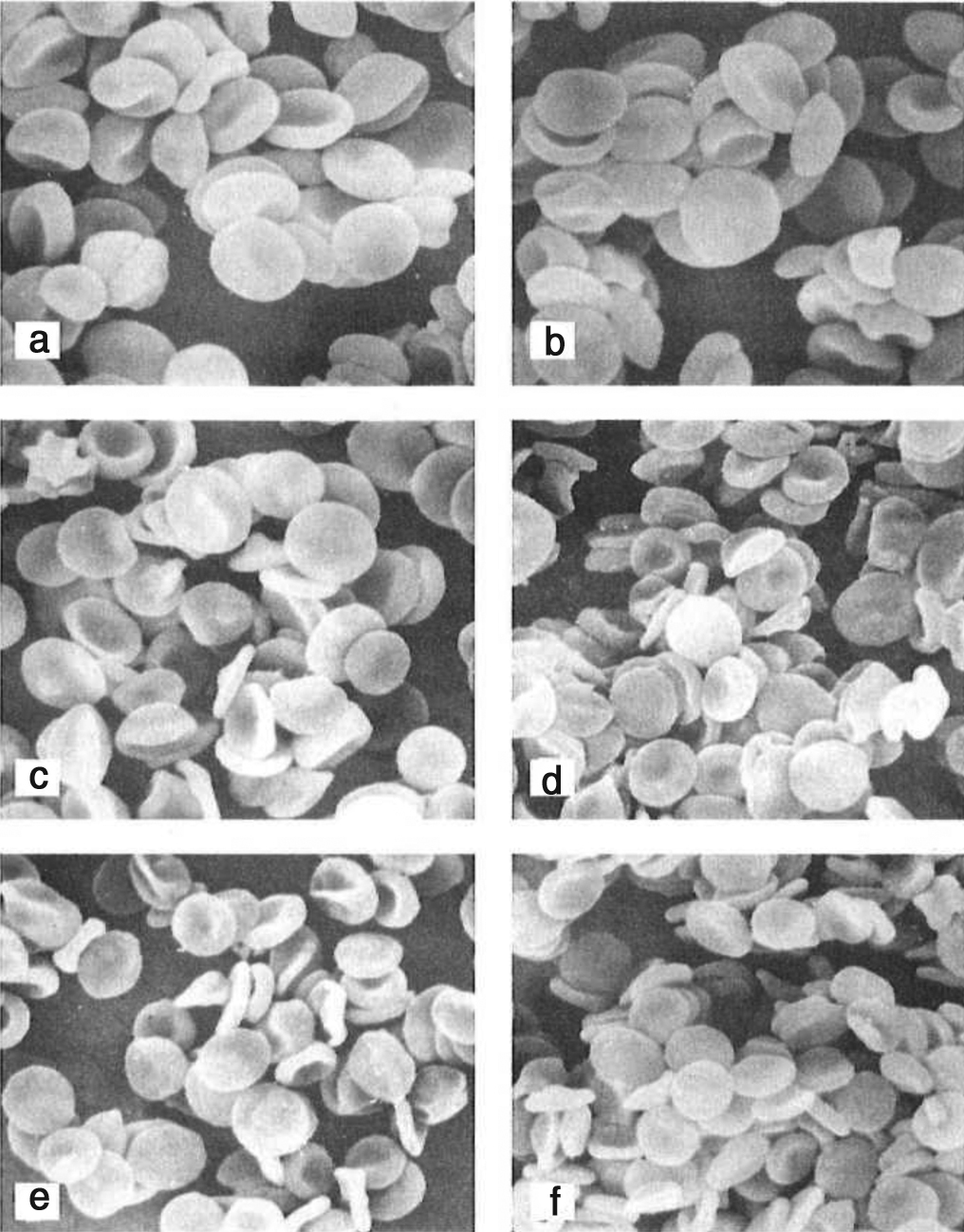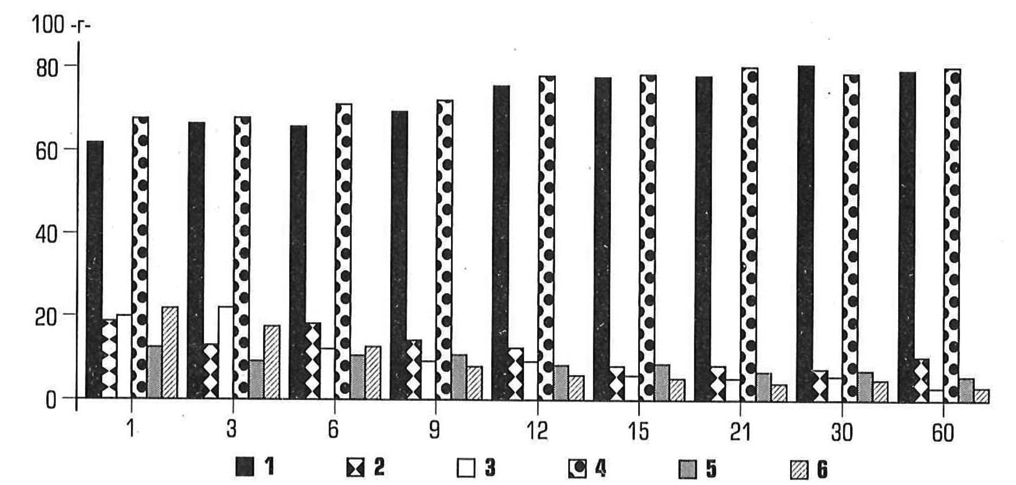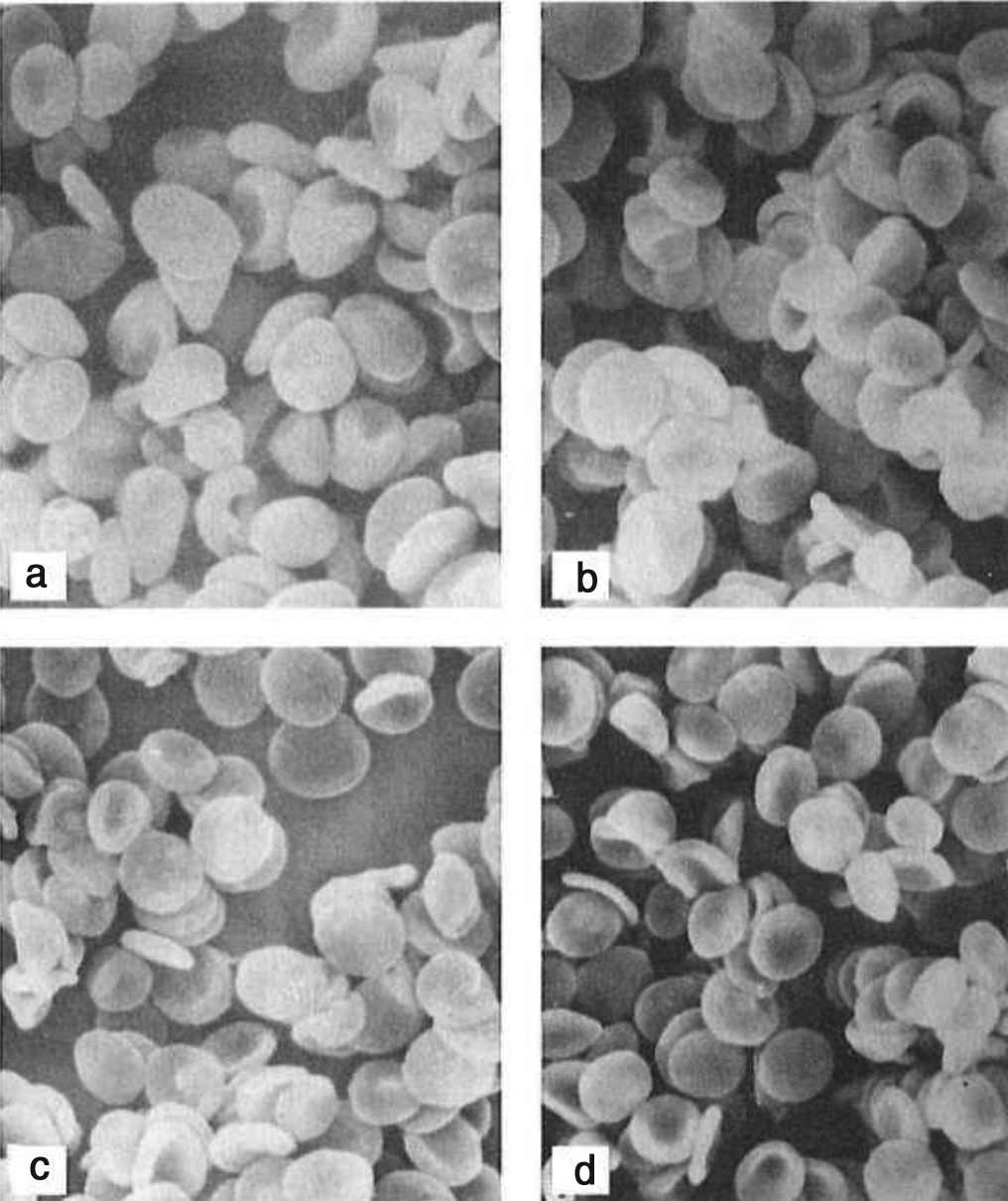Role of motor mode of pregnant in erythrocyte morphology in postnatal ontogenesis
Фотографии:
ˑ:
PhD, Professor V.P. Kartashev
Dr.Med., Associate Professor S.V. Shmeleva
PhD, Associate Professor N.V. Karpova
PhD, Associate Professor E.I. Dubrovinskaya
Russian State Social University, Moscow
Introduction. Erythrocytes, being the most reactive cells that change under the influence of endogenous and exogenous factors, are a unique indicator of various after-effects of adjustment of shifts in homeostasis occurring both under normal and pathological conditions, and as a result of stress stimulation [3, 4, 5, 6, 7, 8].
The study of changes in the shape and size of erythrocytes in terms of formation of the respiratory function of blood in postnatal ontogenesis is of great interest, particularly with regard to morphofunctional reorganization in the red blood cell system of offspring, whose mothers were exposed to stress throughout the entire pregnancy.
Objective of the research was to study the age-related morphological and functional alterations in red blood cells and analyze changes in erythrocyte morphology of offspring, whose dams were forced to swim for an hour and a half each day of their pregnancy.
Methods and structure of the research. The studies were conducted on albino Wistar rats in one-day to adult stage. In obtaining live offspring, female rats of approximately the same body mass of 180-200 g were selected. They were kept 8 to a cage. Upon prospective adaptation, 3-4 male rats of approximately the same body mass were fit in for 24 hours for mating. Mated female rats (which was determined by the presence of sperm in the cervical smears) were moved away and placed into individual cages, where they were kept under the conditions of unlimited feeding and drinking. Starting from the 1st day after birth, infant rats were distributed by 8 for 1 lactating female. On the 30th day they were weaned and placed 8 to the cage, males kept separately from females. A total of 2 series of studies were conducted.
During the first series, we analyzed the morphological and functional characteristics of the red blood cell system in postnatal ontogenesis of rats. During the second series, we studied the impact of prenatal stress on postnatal formation of the red blood cell system. For this purpose, female rats were forced to swim daily for an hour and a half at water temperature of about 32 ºC throughout the entire pregnancy. The reference group was made of infant rats from untreated dams. Further on, to analyze the test characteristics, we took blood samples in the animals of the first and second series on the 1st, 3rd, 6th, 9th, 12th, 15th, 21th, 30th, and 60th days. In all cases, blood was sampled in a "cold room" starting from the 1st up to the 12th days of life during decapitation, and later from the tail. Red blood cell morphology was studied using the scanning electron microscopy method. The preparations were tested by means of the scanning electron microscope "S-405 A HITACHI" (Japan). To determine the percentage ratio of erythrocytes of various shapes in each animal, we made 1-2 blood preparations and as many scanning images as would provide at least 200 erythrocytes. At least 1000 different shapes of erythrocytes were detected in the scanning images and then expressed as a percentage. The average diameter was determined on a 100-cell basis. The quantitative data, obtained when analyzing the scanning images, was processed using the morphometry method by G.G. Avtandilov [1]. The significance of the data differences was assessed using the Student's test.
Results and discussion. The scanning electron microscopy showed that erythrocytes in new-born rats are characterized by pronounced poikilocytosis, unlike those in adult animals. If the total number of erythrocyte shapes is taken as 100%, then the number of discocytes on the first day of life will be 61.5 ± 1.54%, echinocytes - 19.0%, and stomatocytes - 19.5% (Fig. 1, 2). Further, starting from the 6th day of individual development, against the background of decreasing number of echinocytes and stomatocytes, a gradual increase in the number of discocytes was observed during the natural body growth, which on the 30th day of life reaches the level typical of adult rats (p<0.001).
At the early stages of ontogenesis, erythrocytes are characterized by anisocytosis. On the 1st day of life, the diameter of erythrocytes in rats varies significantly, and their average size amounts to 5.63 ± 0.06 c.u. On the 3rd day, the average diameter of erythrocytes reduces significantly (p<0.02), and this value remains unchanged up to the 12th day of postnatal ontogenesis. On the 15th day, once again the average diameter reduces significantly (p<0.001) and remains unchanged up to the 21st day of life, getting smaller up to the end of our survey.

Fig. 1. Changes in erythrocyte morphology in postnatal ontogenesis of rats. Horizontal axis - age of animals in days, AD – adult animals; vertical axis - number of cells of specific shape expressed in % of the total amount.
Therefore, the average diameter of red blood cells reduces significantly in postnatal ontogenesis. Proceeding from the above, the weaning period is characterized by the 3 stages of significant reduction in the average diameter of red blood cells: from 1st to 3rd, from 12th to15th, and from 21st to 30th day of life.

Fig. 2. Dynamics of changes in erythrocyte morphology in postnatal ontogenesis of rats: a – 1-day-old, b – 3-day-old, c – 12-day-old, d – 15-day-old, e - 21-day-old, f - adult animals. SEM. X1000
The study of erythrocyte morphology in postnatal ontogenesis of offspring, whose dams were under stress throughout the entire pregnancy being forced to swim for an hour and a half every day, revealed that daily exercise affects significantly the architectonics of red blood cells. Antenatal exposure to stress during the first three weeks of postnatal ontogenesis leads to an increase in the number of discocytes. Further, on the 30th day of life, their number drops below the values of the control group and reaches their level at the age of two months (Fig. 3, 4).

Fig. 3. Changes in erythrocyte morphology in postnatal ontogenesis of rats, whose dams were forced to swim for an hour and a half every day of their pregnancy. Horizontal axis - age of animals in days, vertical axis - number of cells in conditional units of the total amount. 1- discocytes, 2 - echinocytes, 3 - stomatocytes in reference group; 4 - discocytes, 5 - echinocytes, 6 - stomatotsity in study group.

Fig. 4. Late reduction in average diameter of erythrocytes in postnatal ontogenesis of rats, whose dams were forced to swim for an hour and a half every day of their pregnancy: a – 1-day-old; b - 12-day-old; c – 21-day-old; d – 30-day-old. SEM. X1000
The average diameter of discocytes in infant rats of the study and reference groups does not differ during the first two weeks of life. Starting from the 15th day, it is beginning to reduce in the reference group, while in the study one this index starts to decrease only on the 30th day of life.
Conclusion. The observable changes in the offspring of the dams, who were forced to swim for an hour and a half each day of their pregnancy, lead to delayed erythron genetic program development in postnatal ontogenesis, which significantly affects the respiratory function of blood. These data confirm the position of A.I. Kliorin [2], according to which there are extra-sensitive periods of ontogenesis, during which external factors have the maximum effect on the development of particular body systems and functions (extra activation).
References
- Avtandilov G.G. Meditsinskaya morfometriya. Rukovodstvo [Medical morphometry. Guide]. Moscow: Meditsina publ., 1990, 384 p.
- Demikhov V.G. Etiologiya i patogenez anemii beremennykh [Etiology and pathogenesis of anemia in pregnant women]. Voprosy gematologii, onkologii i immunologii v pediatrii, 2004, vol. 3, no. 1, pp. 36-42.
- Kliorin A.I. Ozhirenie v detskom vozraste [Obesity in childhood]. Leningrad: Meditsina publ., 1989, 255 p.
- Makarova E.V., Kartashev V.P. Izmeneniya v sisteme krovi i neyroendokrinnoy sisteme u studentov so spasticheskimi i vyalymi parezami kak kriteriy podbora sredstv i metodov fizicheskoy reabilitatsii [Changes in blood and neuroendocrine systems in students with spastic and flaccid paresis as a criterion for selection of means and methods of physical rehabilitation]. Uch. zapiski Rossiyskogo gosudarstvennogo sotsialnogo un-ta, 2015, vol. 14, no. 2 (129), pp. 64-70.
- Tarasova L.V., Kartashev V.P. Informativnye pokazateli spetsialnoy rabotosposobnosti kvalifitsirovannykh sportsmenov [Informative indicators of special working capacity of skilled athletes]. Sb. mater. XII Vserossiyskogo sotsialno-pedagogicheskogo kongressa "Sotsialnoe obrazovanie v usloviyakh integratsii Rossii v mirovoe obrazovatelnoe prostranstvo" [Proc. XII All-Rus. Socio-pedagogical Congress "Social Education within Russia's integration into the world educational space]. RF Ministry of Education and Science, Russian State Social University, Institute of Cultural Studies of Education of the Russian Academy of Education, 2012, pp. 441-442.
- Khoroshaev V.A., Kasymov A.H., Kartashev V.P. Strukturnye izmeneniya eritrotsitov i endoteliya pri vnutrisosudistom lazernom obuchenii krovi [Structural changes of red blood cells and endothelium during intravascular laser blood irradiation]. Morfologicheskie osnovy nizkointensivnoy lazeroterapii [Morphological basics of low-intensity laser therapy]. Tashkent: AbuAlibnSino publ., 1991, 223 p.
- Strizhakov A.N., Strugatskiy V.M., Shahlamova M.N. Printsipy i etapy vosstanovitelnoy terapii posle trubnoy beremennosti [Principles and stages of rehabilitation therapy after tubal pregnancy]. Akusherstvo i ginekologiya, 1996, no. 3, pp. 9-11.
- Shmeleva S.V., Kartashev V.P. Kharakter dvigatelnoy aktivnosti zhenshchin starshey vozrastnoy gruppy [The nature of physical activity of women of senior age group]. Chelovecheskiy kapital, 2011, no. 12 (36), pp.160-161.
Corresponding author: kvpmos@mail.ru
Abstract
Subject to the study was the morphological and functional transformations of erythrocytes in postnatal ontogenesis of rats and effects of physical prenatal stress (modelled by swimming practices taking 90 minutes per day for the whole pregnancy period) on the bodily hormonal status on the whole and the red blood cells morphology in particular in the postnatal ontogenesis of the newborns.
It was found that the morphological and functional transformations of erythrocytes may notably vary in the rats’ postnatal ontogenesis with stresses. The initially low percentage of discocytes in the newborns was found to gradually increase with the body growth and development process to attain the typical adult rates in 30 days. The low rates of discocytes in the early ontogenesis were found to associate with high percentages of discoid- and non-discoid-shaped blood cells. Average diameters of the red blood cells were found to start contracting by day 15 with the erythrocyte formula being fully formed by day 30 when mothers normally stops nursing the newborns.
The prenatal stress modelled by the swimming practices taking 90 minutes per day for the whole pregnancy period was found to delay the morphological and functional transformation of erythrocytes in the newborns that may be interpreted as indicative of the important role of the intrauterine growth time in the blood aspiration system formation process of the postnatal ontogenesis. This finding demonstrates the need for the expectant mothers being duly protected from physical overloads to secure the red blood system being well developed in the newborns.



